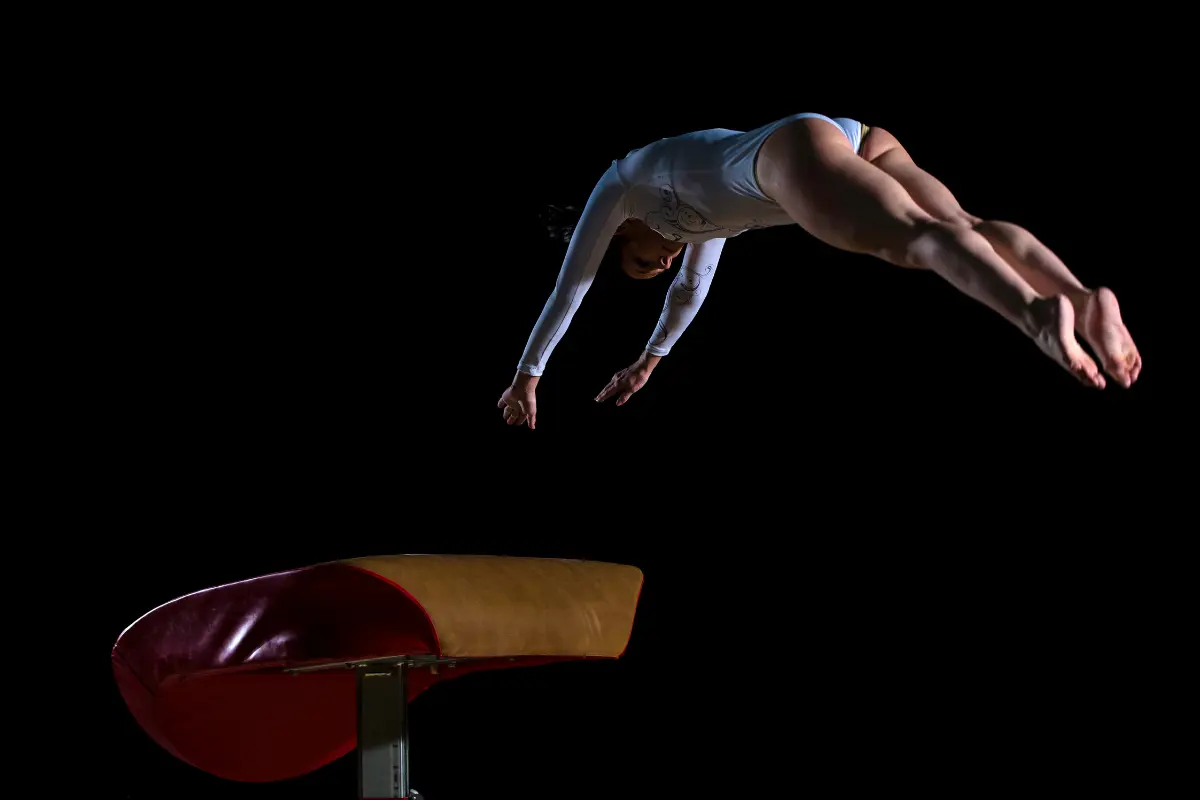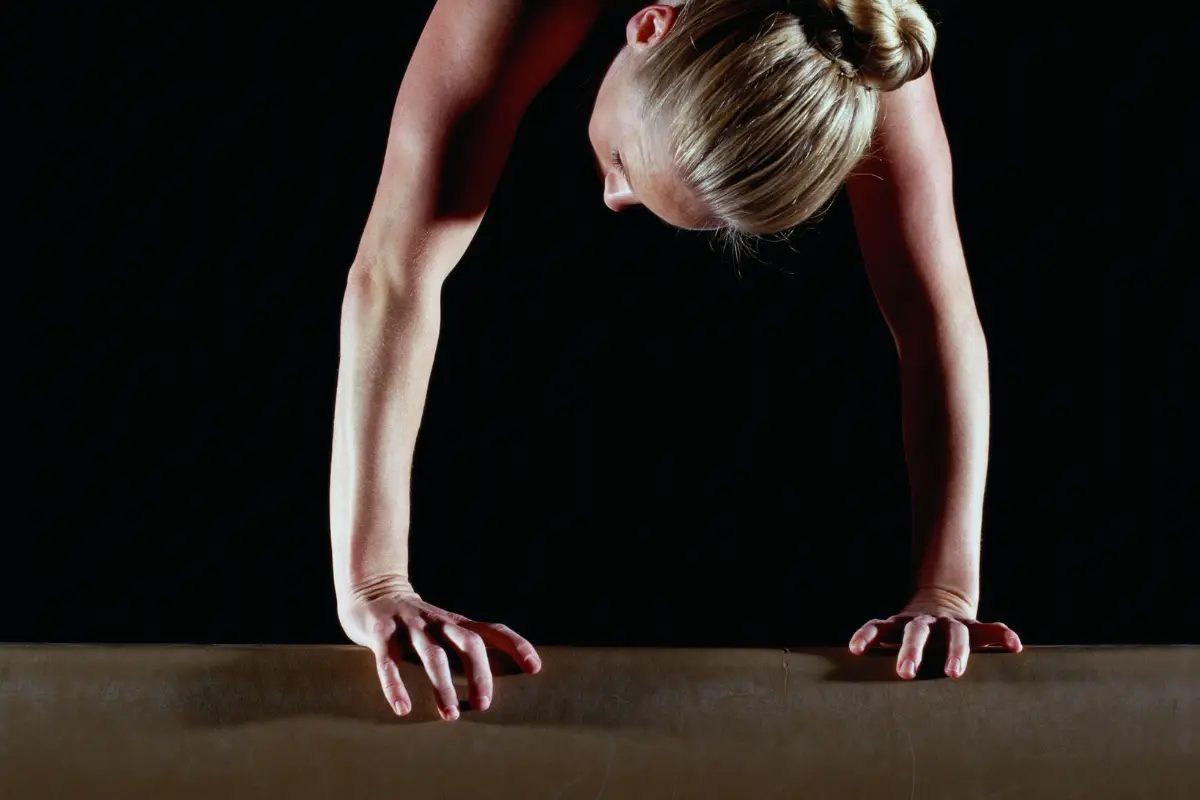Simone Biles’ Yurchenko double pike, officially the Biles II, is the hardest women’s vault ever recognized in the FIG Code of Points. It blends a blistering run, a powerful Yurchenko entry, and two backflips in the pike position before a blind landing.
In 2023, when Biles completed it at the World Championships in Antwerp, FIG named it after her and assigned it a 6.4 difficulty value, the highest of any women’s vault in the current 2025–2028 Code.
What is the Yurchenko Double Pike Vault?
A Yurchenko vault starts with a run, hurdle, and round-off onto the board, turning the gymnast to face backward; she immediately back handsprings onto the table and blocks (explosively pushes) to launch upward and back.
From that block, Biles performs two full backflips in a pike position (hips folded, legs straight) before opening to land. No twists. The pike shape increases rotational demand versus a tuck, so the gymnast needs exceptional height and snap-down to complete the second flip cleanly.
Why it’s named for Biles
FIG names new elements after the first gymnast to successfully perform them at the World Championships or the Olympic Games. Biles did exactly that in Antwerp on October 1, 2023. With that landing, the vault was officially recorded as the Biles II with a 6.4 difficulty rating.
Why This Vault is Historic
Before Biles, no woman had ever landed a Yurchenko double pike in competition. She first showcased it at the 2021 GK U.S. Classic, previewing a skill long thought to belong only to men’s gymnastics. Two years later, she made it official by landing it at Worlds in Antwerp, which cemented its place in the Code of Points under her name.
At Antwerp, judges confirmed the difficulty at 6.4, making it the hardest women’s vault. Originally, under the previous Olympic cycle, the vault had a provisional value of 6.6, but values across the table were re-scaled in the current Code, leaving today’s number at 6.4.
What Makes the Yurchenko Double Pike So Hard?
The Yurchenko double pike is one of the hardest vaults in women’s gymnastics for good reason. It demands strength, speed, and razor-sharp precision. Here’s why it’s such a challenge:
1. Power and Speed
The vault starts with a round-off onto the springboard, followed by a back handspring onto the vaulting table. To pull off the double pike, the gymnast needs a huge amount of speed and power just to push off the table high enough to complete the two flips in the air. Without the right momentum, the vault won’t have enough height or rotation, which can make it impossible to finish.
2. Two Somersaults in the Air
The gymnast has to do two flips in the air while holding a pike position, which means bending at the waist with straight legs. This is tough because staying compact while spinning is key to getting the right rotation. If the gymnast opens up too early or doesn’t flip fast enough, she could end up under-rotating or over-rotating, leading to a mistake or fall.
3. Air Awareness
When performing this vault, gymnasts need to be super aware of their body position in the air. They have to know when to open up and get ready for the landing. If they don’t spot the ground at the right moment, they might land too early or too late, which can cause a messy or risky landing.
4. Perfect Landing
The landing is one of the trickiest parts of the Yurchenko Double Pike. The gymnast has to land with her body fully extended, with her legs straight and locked, to avoid deductions. Even a small mistake—like stepping out of bounds or wobbling—can cost valuable points. The ability to land perfectly, without any imbalance, is crucial for a good score.
5. Risk of Injury
Because of how powerful and complex the Yurchenko Double Pike is, there’s a higher risk of injury. A wrong move, especially during the landing or while rotating, can lead to serious harm. Only the most experienced gymnasts, like Simone Biles, attempt this vault because of the risks involved.
6. Mental Focus
Finally, executing such a difficult vault requires incredible mental focus. The gymnast has to trust her skills and block out any fear or hesitation. Any doubts can throw off the timing, making it harder to execute the vault successfully.
How It Compares to Other Ultra-Difficult Women’s Vaults
| Vault (women) | Entry | Saltos/Twists | Current D (2025–2028) |
|---|---|---|---|
| Biles II – Yurchenko double pike | Round-off → BHS onto table | Double back, pike | 6.4 |
| Produnova – handspring double front tuck | Handspring | Double front, tuck | 6.0 |
| Yeo – RO ½-on, front layout double twist | Yurchenko ½-on | Front layout 2/1 | 6.0 |
| Cheng – RO ½-on, front layout 1½ twist | Yurchenko ½-on | Front layout 1½ | 5.6 |
| Tsukahara 2½ (layout) | Tsukahara | Back layout 2½ | 5.6 |
Step-by-Step: The Biles II Mechanics
- Approach & Hurdle: Long, aggressive run; round-off onto the springboard with shoulders stacked and core tight.
- Back Handspring Contact: Clean, fast hand placement with fully open shoulders; heels driving up to load the block.
- Block & Rise: Explosive shoulder extension creates vertical lift; hips snap into a tight pike.
- First Piked Salto: Core stays rigid, arms wrap to thighs, shape remains precise.
- Second Piked Salto: Maintain the pike; prepare to open at a consistent height.
- Open & Land: Chest up, arms tight, heels together—landings are blind, so timing is everything.
FAQ
Is anyone besides Biles competing it?
As of now, no. The Biles II remains unique to her, officially named because she was the first to land it at a FIG event.
Why not “just” do it in tuck?
A tuck rotates faster, but the element is specifically defined as a pike. The pike makes the vault harder and is what gives it its 6.4 value.
Didn’t it used to have a higher number?
Yes. When Biles first showed the vault in 2021, it carried a provisional value of 6.6. The current Code re-scaled vault values, and it now sits at 6.4.
Source: Gymnastics.sport, Wikipedia, NBC Sports






